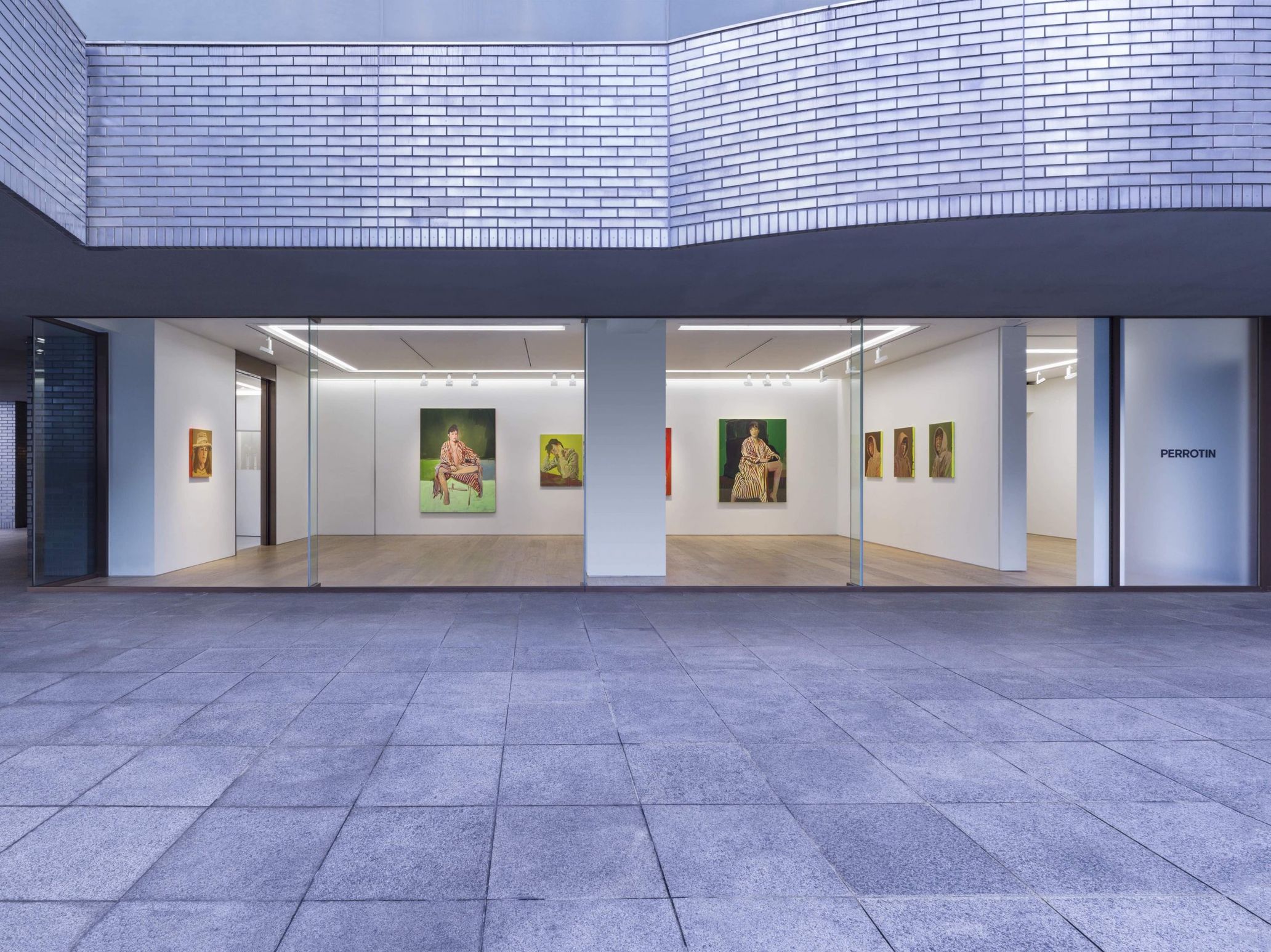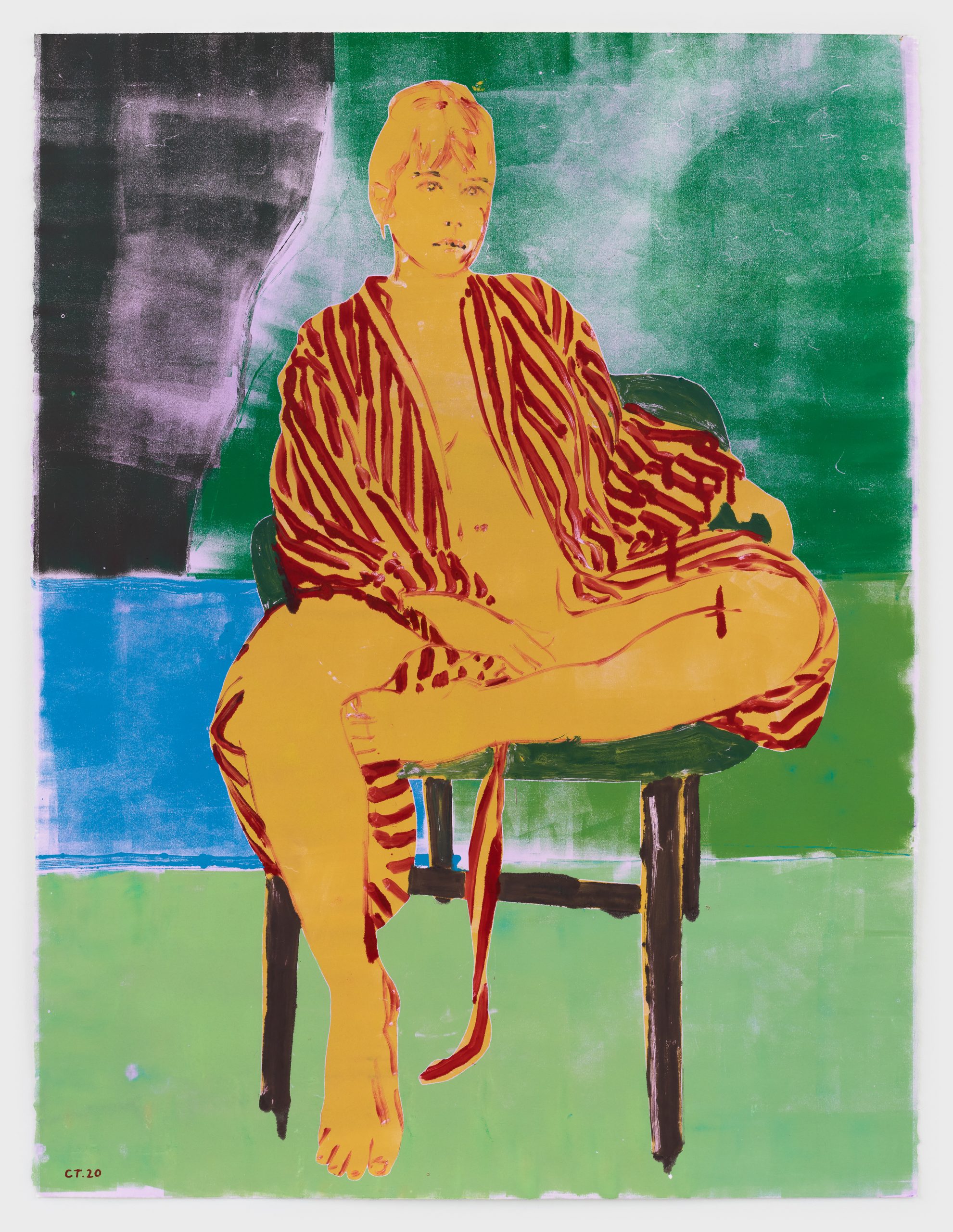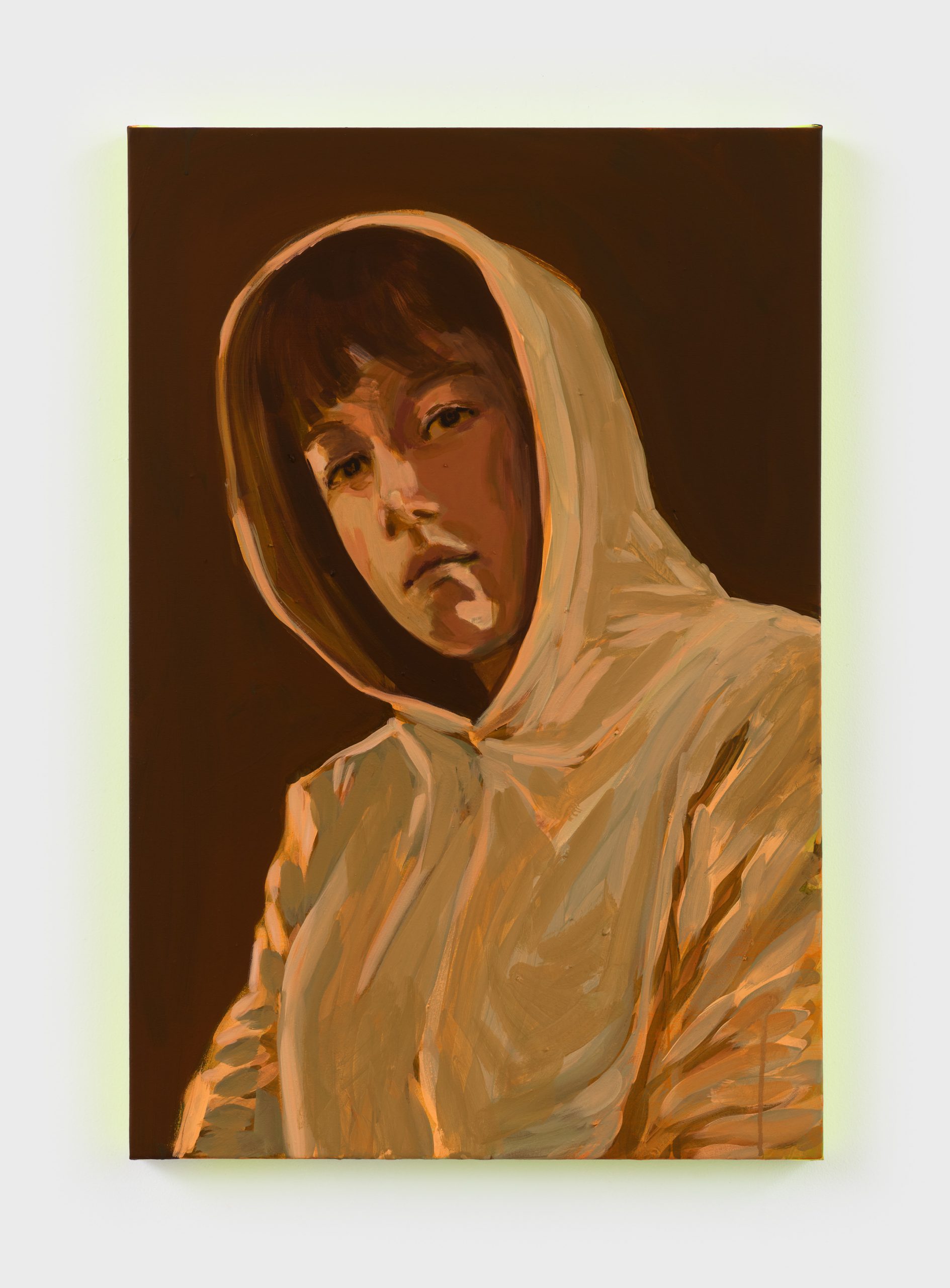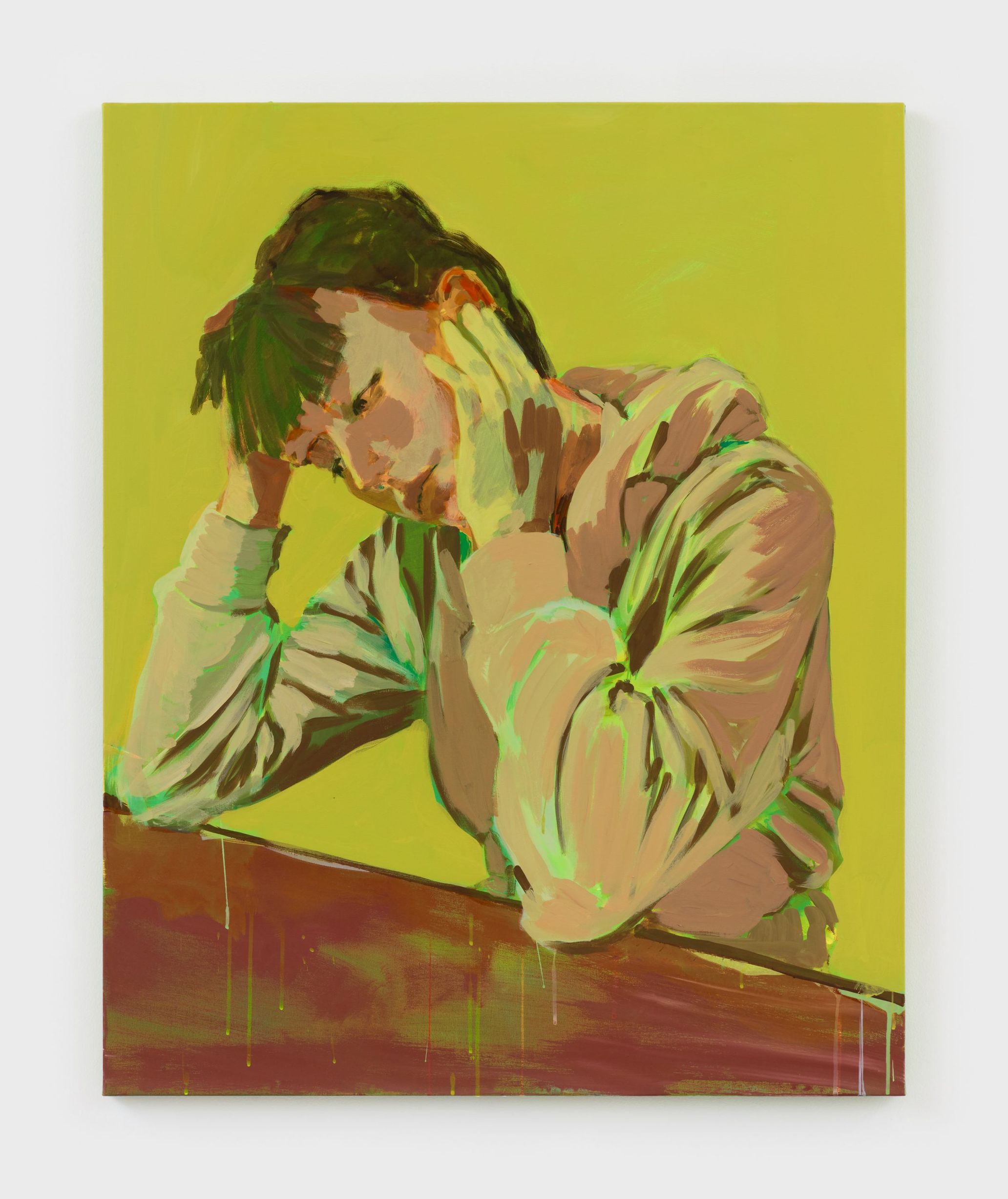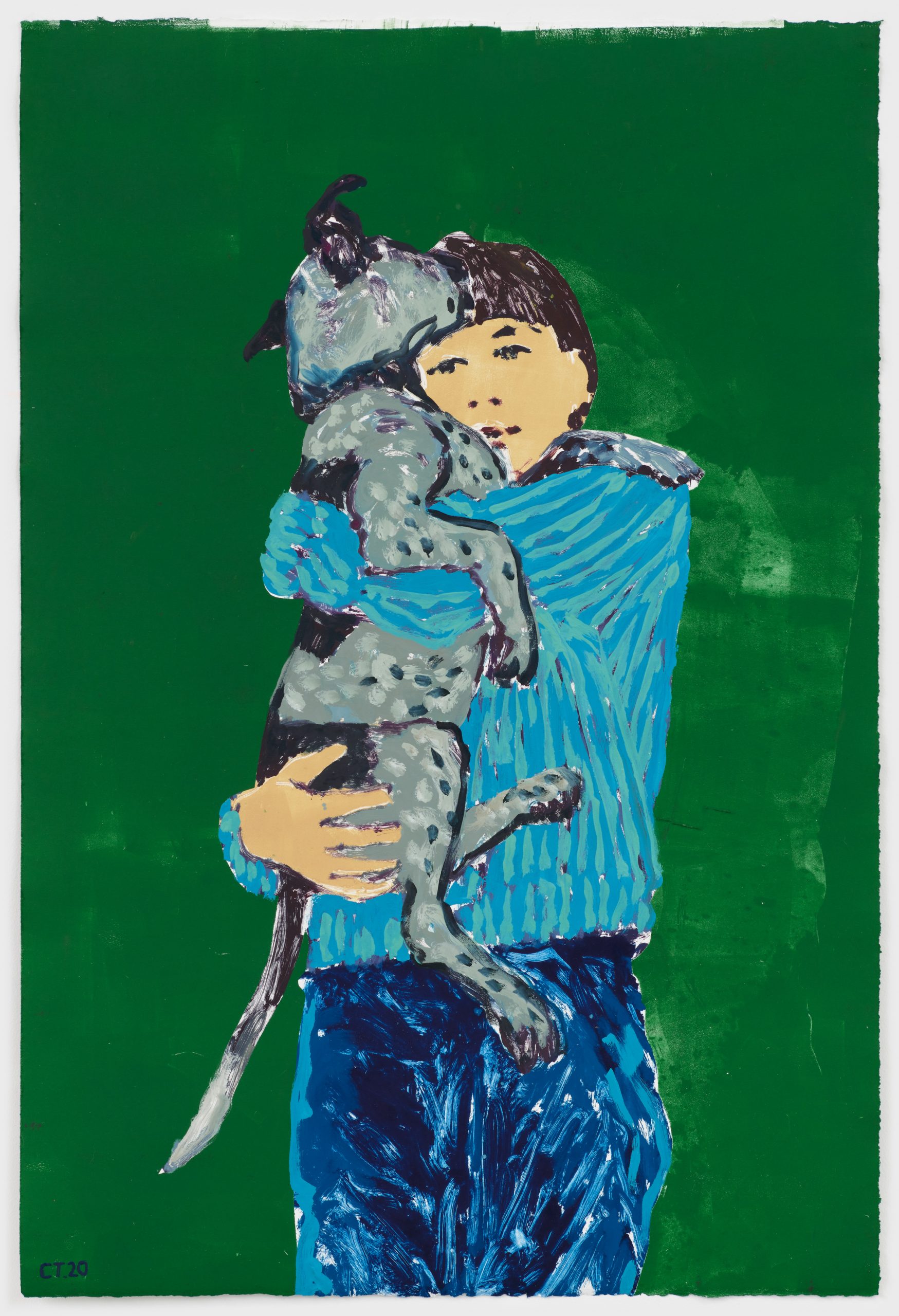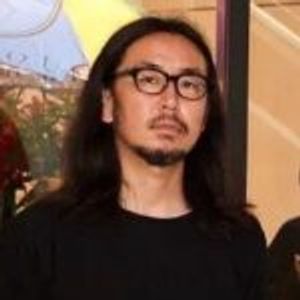French artist Claire Tabouret has worked on portrait works that focus on the relationship between two or more people, including hugging couples, wrestling men, and children in disguise. It has been highly evaluated in museums and galleries around the world. Her works are also known for being collected by such as François-Henri Pinault, CEO of the Kering Group, and Agnès Troublé, the founder and designer of Agnès B.
The exhibition “Lockdown Self-portraits” by Claire Tabouret opens at Perrotin Tokyo until December 26st. While the worldwide lockdown causes loneliness for everyone in a suffocating modern society, she looks inside herself and presents a series of monoprints, one of the new self-portrait paintings and printmaking techniques that portray her own personality.
Her several works show the element of clothes and makeup function as “armor” that hides a part of the body. The motifs repeatedly appear in this new work, such as thick bathrobes, hooded sweatshirts, and pet dog George, bring homely warmth and relief, on the other hand, they serve as shelters. It also expresses the Tabouret’s urge to disappear.
What did Claire Tabouret see when she faced herself again in response to the uncertainty in the COVID-19 era?
Photography Kei Okano Courtesy of Perrotin
――This is your first solo exhibition in Japan although you were unable to come to Japan due to the corona crisis. What are your feelings for Japan?
I love Japan and I wish I could be there for the exhibition. I’m disappointed to not be able to visit right now, but I’m looking forward to next time!
――How did you feel when you had to face yourself during the uncertainty of the world situation?
At first I felt that I would have much more time to paint due to the new, seemingly slower nature of daily life. But actually, it has been the contrary, because my mind is so occupied by processing the news and uncertainty of the world. We are all going through a challenging time and dealing with a lot of uneasiness, but painting helps me to process these experiences and to find a meaning in every day life.
――You have made a number of works focusing on the relationships between people, both imaginary and real friends. How did you come to focus on relationships with people in the first place?
When I was painting landscapes, they were really about memory, and about the events that happened at that place. Even when there was no figure in the painting, I could feel the presence of the people who had been there. I had this similar feeling when painting boats with groups of people on them, so I started to zoom in on the faces and eyes of the distant figures. Once these figures were closer, I became interested in the confrontation between the figure and the viewer, and the relationships between the figures themselves.
――The motivation for this exhibition “Lockdown Self-portraits” came from the situation that an “individual” had to face during the lockdown. What were your reasons that you started drawing yourself?
Self-portraiture has always been a part of my practice, but the sudden isolation caused by the lockdown compelled me to start painting myself out of necessity. It was in this very natural way that I began painting myself, because the urgency to paint is always there, no matter what. The idea of painting other people didn’t feel right, so I just did with what I had in these times, which is myself.
――I felt a moment of tranquility and relaxation in your painting on canvas where you were dressed casually or just wearing a gown over your naked body at home. On the other hand, I could sense the tension from the background color and the running ink. How did your emotions change as the surrounding situation changed so rapidly?
I have always felt that painting is a very dynamic process- it’s constantly changing. This feels especially true when painting people, because humans are almost entirely made of water and the surface of their face moves and changes like water as well. In this way painting allows me to capture and react to changes, whether they are emotional or physical. You can see these subtle changes in the paintings as well as the monoprints, as they’re all depictions of me, but not quite identical.
Acrylic and ink on paper Unframed : 142 x 108 cm Photography Marten Elder Courtesy of the artist and Perrotin
Acrylic on panel
76 x 51 x 3.5 cm
Photography Marten Elder Courtesy of the artist and Perrotin
――At the press preview, you talked about the use of fluorescent colors, saying that “they are artificially created colors that are not found in nature or the human body, so they create an atmosphere that is linked to dreams and imaginary worlds.” Could you please elaborate? Is this because of how you felt in your real life as you had more time to imagine things during the lockdown?
To quote Agnes Martin, “There are two endless directions. In and out.” I feel that my work finds its inspiration in the outside world, my real life, etc. but painting allows me to reflect on these situations through a different lens, in a totally mental world. That’s why these colors are in a way artificial- they’re happening in an otherworldly place.
――Do you ever consciously think about something in your portraits?
Every portrait starts with an intuition of colors & composition in order to evoke a certain feeling or situation. It’s an internal urge that guides each painting, not necessarily something I consciously decide to paint.
Acrylic on panel
61 x 46 x 3.8 cm
Photography Marten Elder Courtesy of the artist and Perrotin
Acrylic on canvas
100 x 81 x 2 cm
Photography Marten Elder Courtesy of the artist and Perrotin
Acrylic and ink on paper Unframed : 112.5 x 76 cm Photography Marten Elder Courtesy of the artist and Perrotin
――Your portraits of Yoko Ono and Villa Medici in Rome in 2017, and the women in the make-up series of women’s portraits in the Yuz Museum in Shanghai look serene at a first glance, but I see darkness hidden in many places that makes me feel unease but in a good way. What is your stance on creating portraits?
The make-up portraits are about embracing stains or imperfections- wearing them proudly and fiercely like war paint. They’re the opposite of actual makeup, which is often used to make a face look perfect. The make-up in these portraits is slippery and artificially placed. They can evoke madness or weirdness, and can even be disturbing, but they’re still strong.
――You’ve expressed the importance of community and connection in the past, but what are your thoughts on communication given the situation caused by the pandemic?
My works often deal with proximity, with the relationships between people, and how people occupy space within a group. During the pandemic, there are no gatherings and there’s very little closeness to other people. That has definitely put a strain on communication in many ways, as it’s very human to want to be near each other. The lack of connection to others played a big role in my compulsion to paint self-portraits.
――What kind of works do you want to create in the post-Corona?
I want to create works about proximity, physical closeness, gatherings, people getting together for dance parties, jumping around in a room with 80 people. I’m looking forward to making work about all the things we have been missing out on over the last several months.
Claire Tabouret
Born in France in 1981, based in Los Angels currently. Her works are collected by Los Angeles County Museum of Art, François-Henri Pinault, CEO of the Kering Group, and Agnes Troublé, the founder and designer. She also had the exhibitions with Yoko Ono at Villa Medici in Rome and Yuz Museum in Shanghai in 2017.
■LOCKDOWN SELF-PORTRAITS
Open:until December 26st, 2020
Location:Perrotin Tokyo
Address:6-6-9 Roppongi, Minato City, tokyo
Hours:12:00 -18:00(by appointment only)
Closed:Sunday and Monday
Admission:free
Website:www.perrotin.com
Translation elie Inoue



